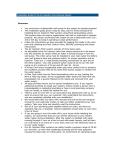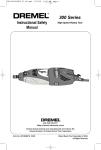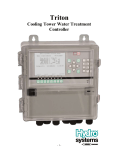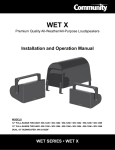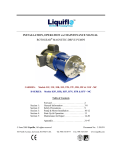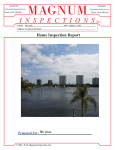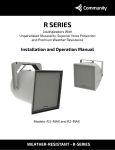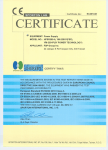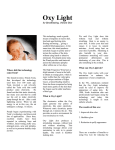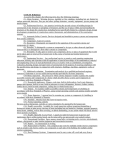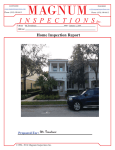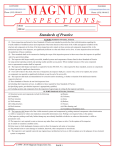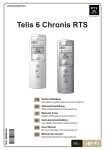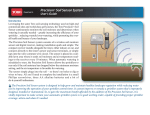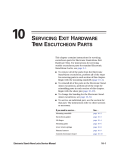Download 2-10 Warranty - Home Maintenance Manual
Transcript
YOUR HOME maintenance manual Offered by Home Buyers Warranty Corporation Your Home Maintenance Manual Published by: Home Buyers Warranty Corporation www.2-10.com Copyright 2002 All Rights Reserved Customer Service Office One Denver Highlands 10375 East Harvard Avenue, Suite 100 Denver, Colorado 80231 720-747-6000 www.2-10.com 1 INTRODUCTION Congratulations on the purchase of your new home! Home Buyers Warranty Corporation knows what an exciting and overwhelming time this can be. We’ve designed “Your Home Maintenance Manual” to smoothly guide you through some of the important details involved with properly maintaining your new home. We’ve done the research for you. As a new home warranty provider, we’ve heard many questions new homeowners ask like: Î Î Î Î Î “What should I do?” “Why should I do it?” “When should I do it?” “How can I do it?” and, “Does the warranty cover it?” On the pages that follow, you will read answers to these questions. So take a moment and review this manual, as we take you on a maintenance tour of your new home! A good idea? Mark your calendar for 30 days after moving in and review this helpful manual which includes monthly maintenance tips and suggestions. Keep this manual, your home warranty booklet, manufacturers’ warranties and insurance documents together for easy access and review. Please, always remember to check your Home Buyers Warranty booklet or ask your Builder about possible warranty coverage before hiring a contractor to perform any corrective work. We have included some helpful forms at the end of this booklet. The maintenance outline included in this manual is a suggested schedule only. The manufacturer's maintenance guidelines should be followed instead of our suggestions when a discrepancy occurs. SAFETY FIRST - Often homeowners want to “do-it-themselves” to save money. Remember, there are many areas of home maintenance that are best left to professionals. Electrical work, entering an attic and climbing on roofs and ladders are just a few hazardous areas. Be safe! Call a professional. 2 CONTENT BEFORE THE MOVE CHECKLIST 4 AFTER THE MOVE CHECKLIST 4 APPLIANCE AND SYSTEMS CATALOG 6 HOME MAINTENANCE REPAIR CONTRACTORS 7 MAINTENANCE CALENDAR 8 PERSONAL NOTES 10 OUTSIDE THE HOME Roof and Chimney 11 Gutters and Down Spouts 11 Siding, Paint, Masonry, Stucco, EIFS & Wood Trim 12 Caulking - Windows / Doors 12 Concrete Slabs and Patios 12 Grading, Drainage & Landscaping 13 Septic Tanks & Leach Fields 13 11 INSIDE THE HOME Attic Floor Coverings Wall Finishes Cabinets and Countertops Wood Trim Doors & Windows Appliances Foundation, Basement & Crawl Space Plumbing System Plumbing Fixtures and Appliances Heating & Cooling System Electrical System 14 14 14 15 16 16 17 17 18 18 19 20 22 FORMS 3 BEFORE THE MOVE ESTABLISH UTILITIES IN YOUR NAME: Î Power Company Î Water Service Î Gas Company Î Telephone Service Î Security Company Î Cable or Satellite Service Î Trash Collection Service Î Garage Door Opener (if applicable) Î Internet Service Î Notify the following of your new address. Place(s) of Employment Post Office Insurance Companies Credit Card Companies Social Security Administration Health and Benefits Plans Investment Accounts Magazine Subscriptions Professional Organizations Family Friends TIP: Collect all of your mail for several months prior to moving to be sure you notify everyone who sends you important mail. AFTER THE MOVE Î Find a secure place to store all of the following: 4 Instruction manuals and manufacturer’s warranties for appliances, etc. Home warranty booklet and information Home insurance documents This home maintenance manual which contains important phone numbers for home and appliance contractors Î Change the address on your driver’s license or apply for a new one if moving from another state. Î Register your children in school. Apply for a homestead exemption with your local county tax office, if applicable. Î Register your vehicles if moving from another state. Î Register to vote if moving to a new jurisdiction. Î Put all of your closing documents, warranties, and appliance operation manuals in a common location for easy reference. Î Fill out and mail-in all manufacturer’s warranty information cards for all of your new appliances. Î Purchase fire extinguishers for each floor of the home and a separate one for the kitchen and garage. Î Store all touch-up paint in a common location (but not near your water heater or furnace). Î Locate main water and gas shut-off valves. Î Locate electrical service panel and main shut-off switch. Î Familiarize yourself with the operation of all appliances and equipment. Install contact paper in kitchen cabinets and drawers. Î Install floor protector pads on the bottom of all furniture legs where needed. Î Vacuum out heating/cooling ducts. Î Apply grout sealer to ceramic tile. Î Put together a first aid kit. Î Start a basic tool kit for hanging blinds, curtain rods, pictures, reassembling furniture, installing shelves, etc. Î Identify any Homeowner Association property improvement deadlines. Î Introduce yourself to the new neighbors. Î Offer your old boxes to someone who’s moving. Î Take lots of pictures and video your new house to show your friends, family and co-workers! Enjoy your new home! 5 APPLIANCE AND SYSTEMS CATALOG MANUFACTURER SYSTEMS Air Conditioning Heating System Intercom System Security System Septic System Water Well Mechanical APPLIANCES Built-in Microwave Clothes Dryer Clothes Washer Cooktop Dishwasher Doorbell System Fans - Attic, Ceiling, Exhaust Fire / Smoke Alarm Garage Door Opener Garbage Disposal Oven Plumbing Fixtures Range Refrigerator Trash Compactor Water Heater 6 MODEL TYPE SERIAL NUMBER HOME MAINTENANCE REPAIR CONTRACTORS NAME PHONE SYSTEMS Air Conditioning Electrical System Heating System Intercom System Plumbing System Security System Septic System Water Well Mechanical APPLIANCES Built-in Microwave Clothes Washer and Dryer Dishwasher Doorbell System Fans - Attic, Ceiling, Exhaust Fire / Smoke Alarm Garage Door Opener Garbage Disposal Range / Oven / Cooktop Refrigerator Trash Compactor Water Heater INSIDE HOME Cabinetry Doors, Windows and Trim Flooring Carpet Ceramic / Marble Tile Wood Floors Insulation Painting Plumbing Fixtures OUTSIDE HOME Brick Driveway Gutters and Down Spouts Landscaping Painting Roof Siding Woodwork 7 MONTHLY MAINTENANCE Home maintenance includes regular, seasonal and one-time tasks. The following suggested maintenance schedule identifies some of the more common maintenance tasks that may be performed on a weekly, monthly or on a semi-annual basis. Tailor it to fit your own situation, adding or deleting items as required. As a homeowner, you have normal maintenance responsibilities for your new home. Establishing a maintenance schedule is the best way to manage your maintenance budget. This suggested maintenance tasks and schedule should not replace the manufacturer’s recommendations. We suggest the use of licensed contractors for any tasks you may feel unprepared to complete. Remember, safety first! What seems like a simple plumbing or electrical repair can cost you many times what you think you might save if you don’t do it correctly. THE FOLLOWING IS SUGGESTED MONTHLY MAINTENANCE: ☺ Smoke Detectors - Check operation by pushing test button. Check and replace battery if necessary. ☺ Check fire extinguishers for proper charge. Never buy units without a pressure gauge. Be sure that you have an adequate number, located in kitchen, garage and basement. Test Ground Fault Circuit Interrupters (GFCI) to insure proper protection. ☺ Clean garbage disposal blades by grinding ice cubes and citrus fruit rinds. ☺ Clean or replace dirty filter in range hood. ☺ Check for evidence of leaks around toilets, under sinks and around dishwasher. ☺ Clean and freshen sink drains by flushing with hot water and baking soda. ☺ Inspect furnace and air-conditioning filters, humidifier and electronic air cleaners. Replace as required. ☺ Clean aerators on faucets regularly, depending upon water hardness. You may need to use a rust or scale remover to return them to normal condition, or have them replaced. Check water filters and softeners regularly. The life of the filters is dependent upon water usage and water characteristics. Retailers can help with this analysis. ☺ Monitor and maintain floor coverings on an as required basis. Regular vacuuming will reduce wear of carpets and other floor coverings. Repair tears and remove stains as soon as possible. ☺ Check the Temperature Pressure Release (TPR) valve on the water heater. Water heater should also be drained periodically. In areas with hard water drain at least 5 gallons of water from the drain valve every six months to prevent sediment build up. 8 TWICE-A-YEAR MAINTENANCE ☺ Inspect roof and chimney for broken or missing tiles or shingles, identifying anything that might cause leaks or problems. Inspect and clean gutters and down spouts. Follow instructions in this manual for roof and chimney and gutters and down spouts. Do not walk on the roof as it is dangerous and may cause damage. ☺ Inspect outside of home and condition of siding, paint, masonry, stucco or Exterior Insulated Finish System (EIFS) and wood trim following instructions in this manual. ☺ Inspect doors and windows to verify proper operation, security and weatherresistance. Clean tracks of windows and sliding glass doors before applying silicone lubricant. See suggestions in this manual. ☺ Maintain wall finishes following suggestions in this manual. ☺ Monitor and maintain cabinets and countertops following suggestions in this manual. ☺ Inspect the foundation, basement or crawl space following instructions in this manual. ☺ Inspect main service panel, circuit breakers, all GFI outlets and breakers following instructions in this manual. ☺ Complete seasonal maintenance on heating and air conditioning by licensed HVAC contractor. ❏ Check general condition of compressor; remove debris as necessary. ☺ Inspect and replace as needed caulking and grout around tubs, showers and sinks. ☺ Have carpets professionally cleaned at least once a year. ANNUAL MAINTENANCE ☺ Examine caulking around windows, doors and other areas following instructions in this manual. ☺ Inspect condition of concrete slabs and patios following suggestions in this manual. ☺ Check condition of septic tank and leech field. Consult with septic tank pumping service. ☺ Visually survey wood trim following suggestions in this manual. Clean all woodwork and wax. ☺ Complete annual furnace and air conditioning maintenance by a licensed HVAC contractor. ☺ Schedule professional inspection of major appliances especially if gas fueled. 9 PERSONAL NOTES 10 OUTSIDE THE HOME WHAT ? EXAMINE ROOF AND CHIMNEYS Why ? To identify anything that might cause leaks or problems. When ? Twice a year. How ? For roofs, visually inspect all surfaces from the ground if possible. Look for torn, broken, missing or cracked shingles or tiles, accumulated debris, gaps in flashing, exposed joints, and obstructed vent pipes. Avoid walking on roof tiles – they will crack. Shingle granule deposits found in gutters are normal and common to new roofs. Check that sealed joints around skylight frames are not cracked and in good condition. Look in attic for water stains on underside of roof or wet insulation. Consult with a qualified roofing contractor, as necessary, for correction of any roofing problems. After any snow, ice, high winds and heavy rains, check for water stains under overhang and in attic. Always call your homeowners insurance company first for any storm-related damage. Many attics do not have floors. If you step on the insulation or ceiling, you may be seriously injured. For chimneys, look for open gaps between the house and chimney, cracks in mortar or stucco, and minor settlement. Seal gaps with an appropriate caulk and repaint to match as required. Consult with a mason to re-point or repair mortar and stucco. Never burn pressure-treated wood, Christmas trees, plastic, or flammable liquids in the fireplace. Keep flue closed when not in use to reduce cooling and heating losses. Clean chimney flue once a year. Clean out ashes as necessary – store in a metal container to reduce fire risk. With the return of cold weather, before building the first fire you should 1. Check to see if any of the “fire clay” (mortar) has fallen out, replacing if necessary; 2. Ensure damper works properly and closes tightly; 3. Check the flue with a flashlight for soot build-up. For heavy soot deposits, a professional chimney cleaner should be employed. Warranty Section ? Roofing Fireplaces WHAT ? INSPECT GUTTERS AND DOWN SPOUTS Why ? To make sure they operate as intended. When ? Twice a year. How ? Hire a gutter cleaning service or find a ladder and do-it-yourself. Leaves and debris will accumulate in the gutters as the seasons change. If you do it yourself, carefully climb up to the gutter and scoop out leaves and debris with a small hand shovel. Also, remove debris from the down spouts. (You can sometimes clear these with a hose, but you may have to disassemble the downspout.) After cleaning, consider installing a downspout filter device to keep out debris. Make sure gutters are sloped to drain toward down spouts and that water drains a minimum of five (5) feet away from the foundation as it discharges from down spouts. When on the ground, inspect gutters from underneath and look for leaks, rust spots or holes. Caulk as necessary. Warranty Section ? Sheet Metal 11 WHAT ? CHECK CONDITION OF SIDING, PAINT, MASONRY, STUCCO OR EIFS AND WOOD TRIM Why ? To maintain its good looks and confirm adequate weather protection. When ? Twice a year. How ? Perform a walk-around inspection of the perimeter walls. Over time, normal weathering and minor settlement can cause cracking, peeling, warping, and crumbling in some or all of these materials. Look for cracks in brick, stone, and stucco. Identify any areas where mortar has fallen out. A white powdery substance known as efflorescence may appear from time to time and is considered normal. Check for warped siding, gaps in wood trim, and peeling or blistering paint. Sand, scrape, wire-brush, caulk, stain, repaint and apply wood preservatives where necessary. Consult with a mason, as necessary, to repair cracked brick or mortar and traditional stucco problems. Contact a qualified contractor familiar with the manufacturer’s specifications of repair for homes clad with an Exterior Insulated Finish System (EFIS). Consult with a siding contractor, as necessary, to repair warped siding. Warranty Section ? Unit Masonry Finish Carpentry Painting Stucco and Cement Plaster Exterior Siding WHAT ? EXAMINE CAULKING AROUND WINDOWS, DOORS AND OTHER AREAS Why ? To keep out water, air, dust and insects. When ? Once a year. How ? Walk around the house and inspect each caulking joint at window and door frames, between two different siding materials (like brick or stucco), or around piping which enters the home. Original caulking will shrink and crack over time due to normal weathering. Confirm that caulked joints are still properly sealed and haven’t cracked, pulled apart, or fallen out. If necessary, clean the old joint out with warm soapy water and a toothbrush and reapply the same caulking material to achieve a proper seal. Consult with your local hardware store to select the right type of caulking. Warranty Section ? Sealants WHAT ? INSPECT CONDITION OF CONCRETE SLABS AND PATIOS Why ? To maintain their cosmetic appeal and intended usage. When ? Once a year. How ? Examine all concrete sidewalks, patios, porches, stoops, and garage slabs for cracks, chipping, stains, scaling or settlement. Consult with your local hardware store for products that can fill and repair cracks or chipping, or remove scaling residue. (Automotive brake cleaning fluid works well to remove most concrete stains). Seal and caulk any large gaps created by minor settlement. Warranty Section ? 12 Cast In-place Concrete Construction and Control Joints WHAT ? MAINTAIN ORIGINAL GRADING, DRAINAGE, AND LANDSCAPING Why ? To reduce the possibility of water or foundation damage. When ? At all times. How ? Visually survey your yard and existing drainage patterns. Verify that the ground slopes away from the foundation. Stabilize any bare areas with grass, ground cover or landscaping materials to discourage erosion. Dig out areas where sand has accumulated and fill in any low spots where necessary to re-establish drainage flow. Avoid over-watering plants and shrubs which are next to the foundation. Adjust sprinkler systems to avoid over-spraying the house or causing puddles near the foundation. Plant trees and shrubs an adequate distance away from foundation to allow for mature spread and root systems. Water, fertilize, mow and aerate your grass as necessary. In areas of the country with active (expansive) soils, maintenance and irrigation guidelines specific to your soils and foundation type should be followed. Conventional landscape practices may be inappropriate in these areas, for example; if your home has a pier and grade beam foundation and you live in a semi-arid climate, you may not be able to plant flowers or shrubs closer than five (5) feet from the foundation, unless they have very low water requirements and can be hand or drip-line watered. Sprinkler systems may not spray closer than five (5) feet from the foundation, and trees should not be planted closer than fifteen (15) feet from the foundation. Conversely, if your home has a post-tensioned slab foundation in a moist climate, you may need to take steps to ensure that soils around foundation do not dry out excessively. Again, trees should not be planted closer than fifteen (15) feet from the foundation. Consult with your builder, nursery or landscape professional, as necessary, to correct or learn more about your local soil and growing conditions. Warranty Section ? Grading Drainage WHAT ? CHECK OUT CONDITION OF SEPTIC TANK & LEACH FIELD Why ? To keep your wastewater system working as intended. When ? Once a year. How ? Know the location of your septic tank and drain field. Have your septic tank inspected annually by a licensed contractor or health department official. Inspection will reveal problems before they become serious, and tell you when tank needs to be pumped. Periodically check the drain field for a foul odor, excessive wetness, or overly lush grass growth, which may be warning signs of a failing system. Never drive or park over any part of the system. Do not plant anything but grass over or near drain field, as tree and shrub roots may clog drain field. Warranty Section ? Septic Tank Systems 13 INSIDE THE HOME WHAT ? INSPECT THE ATTIC Why ? To look for any changes since construction. When ? Twice a year. How ? Prior to entering the attic, purchase a paper filter mask from your local hardware store to avoid lung irritation from possible airborne insulation fibers. Bring a flashlight. Gain access through the trap door and check that all air vents are unobstructed and intact. Make sure there are no animals nesting in the insulation. If you walk around, be careful not to step on the drywall ceiling below, and watch out for nails sticking through the roof. Never store anything in the attic unless it was designed for that purpose. Check with your builder for more information regarding storage capacity or lack thereof. Warranty Section ? Insulation Louvers and Vents WHAT ? MONITOR AND MAINTAIN FLOOR COVERINGS Why ? To keep them looking great and preserve their longevity. When ? As required. How ? For carpet, vacuum often. Use very short, slow movements, about 2 or 3 strokes each spot for maximum soil removal. Traffic lanes may require more frequent cleaning, to maintain the upright position of the nap. Spills should be wiped up and stains spot cleaned promptly. Always dab at the stain, never rub it. Use a manufacturer-approved carpet cleaning product as needed — test spray for color fastness in an inconspicuous location (like a closet). Use mats or rugs near outside doors to reduce soil tracking. (Always lift furniture when moving it around – never drag it.) Have carpets professionally cleaned once a year. For ceramic or marble tile, sweep or vacuum often. To clean, use a dishwasher crystal and water solution applied to a damp sponge. Check for cracks in the grout. Apply matching grout as necessary to fill cracks. Check caulking near bathtubs and baseboards. Caulk should be well-adhered to both surfaces – clean surface and re-caulk as necessary. Make sure all furniture legs have floor protectors installed. (Always lift furniture when moving – never slide it across tiles.) Use mats or rugs near outside doors to collect dirt. For hardwood floors, sweep or vacuum often. Use non-rubber backed mats or throw rugs to minimize exposure to sand and grit. When the floor becomes excessively soiled, floors having a polyurethane finish may be damp mopped with a mixture of one cup vinegar to one gallon of water — never wet-mop or wax. If occasional squeaks occur, apply some powdered graphite to the area. The appearance of small splinters is common for new hardwood floors. Avoid exposure to prolonged sunlight and high-heeled shoes (without their rubber heel protectors in-place). Make sure all furniture legs have floor protectors installed. Always lift furniture when moving – never slide it across the wood. Never allow water to sit on the surface for an extended period of time. Over time, with normal use, polyurethane finished floors may need to be recoated. A qualified contractor should do this. Waxing a polyurethane finish is not recommended, as new coatings will not bond to old wax. Other oil or water-based finishes may have different care and maintenance requirements, and you may need to contact the flooring company for the manufacturer's recommendations. 14 For vinyl or other resilient-type flooring, sweep, vacuum or damp mop often. To “wax” your no-wax floor, use acrylic finishes recommended by the manufacturer. Excessive water near seams can cause separation, lifting or curling. High heels will damage these floor types. Install floor protectors on furniture legs and lift furniture when moving – don’t slide! For slate and clay tile, seal to protect and prevent staining. Use diluted detergent or tile cleaner to clean. Warranty Section ? Hard Surface Flooring Resilient Flooring Finished Wood Flooring Carpeting WHAT ? MAINTAIN WALL FINISHES Why? To preserve their good looks and longevity. When ? Twice a year. How ? For drywall, check for cracks at windows, doors, corners, and ceilings. Repair with two to three coats of joint compound, sand and repaint when convenient. Minor cracks can be filled with a heavy coat of matching paint. Look for any nail pops or protrusions. Reset offending nails deeper into drywall, then repeat drywall repair. Most drywall cracks will occur after a heating or cooling season with the change in humidity. (Air conditioners provide very dry air as they cool.) Consult with a drywall contractor to retexture, as necessary. For paint or stain, look for peeling, cracking, blistering, fading, or scuff marks. Scrape off paint from any damaged areas. Flat paint can be touched-up with a small brush and matching paint. Semi-gloss and glossy paint can be touched-up or wiped off with a damp sponge to clean. Exterior paints can usually be used for inside areas however, the opposite is not always true. Do not use an acrylic or latex paint over enamel or varnish, since it will not adhere. Use washable paint in the bathroom, kitchen and utility area. Stain can often be rejuvenated with a good quality furniture polish. For wallpaper, look for loose or curling seams. Changes in humidity can cause seams to separate — reattach with a compatible wallpaper seam adhesive. Keep water and condensation away from all seams. Clean surface as necessary with a damp sponge. For brick or stone veneer, periodically check for cracks in the mortar. Changes in humidity can cause mortar to shrink. Consult with qualified mason, as necessary, to re-point cracks and match existing mortar. Cleaning walls 1. Some painted surfaces may be cleaned with a mild solution of detergent and water. If you are not sure of the washability of the paint, try washing in an inconspicuous place. 2. Glazed brick or tile should be washed with soap and water. Use a non-abrasive household cleaner to remove stains. 3. Wood paneling should be cleaned with a wood cleaning product and then treated with paneling wax or with linseed oil. Warranty Section ? Lath and Plaster Gypsum Wallboard Painting Wall Covering 15 WHAT ? MONITOR AND MAINTAIN CABINETS AND COUNTERTOPS Why ? To maintain their good looks, durability, and intended usage. When ? Twice a year. How ? For cabinets, check out the hardware. Adjust, tighten or lubricate knobs, hinges, latches, rollers, and drawer glides. Refresh varnished wood cabinets with a good quality furniture polish once a month. Never use a paraffin-based spray wax. Painted cabinets may be cleaned with a mild non-abrasive detergent on a damp sponge. Scratches can be filled with a matching touch-up crayon available at most hardware stores. Wood cabinets should be cleaned and waxed just like fine furniture. Plastic-coated cabinets may be cleaned with a detergent solution. For laminate countertops, verify that any caulking joints are in good condition and well-adhered to both sides of the joint – water can cause underlying wood material to swell when wetted. Clean joint and re-caulk with matching material as necessary. Avoid placing hot items such as pots, pans, cigarettes and irons on countertop laminate – heat can liquefy the underlying glue. Never cut on your new countertops – always use a cutting board. Clean with a mild, non-abrasive detergent on a damp sponge or wash rag – don’t use scrubby pads. Avoid prolonged exposure of dishwasher steam to underside of countertop – high humidity and condensation may cause wood warping under laminate. For ceramic tile countertops, inspect grout and tile for cracks. Replace cracked tiles and re-grout as necessary. White grout can be refreshed by applying a diluted bleach solution with a stiff narrow brush. Warranty Section ? Kitchen Cabinets and Vanities WHAT ? VISUALLY SURVEY WOOD TRIM Why ? To preserve its good looks. When ? Once a year. How ? Examine all baseboards, chair rails, crown molding, door frames and window frames. Changing humidity levels can cause wood to shrink, crack and warp. Look for dust accumulation, cracks, corner separations, or warping. Wipe off dust with a damp sponge. For stained trim, treat with a good quality furniture polish. For cracks or corner separations, fill in gaps with a matching wood putty. Treat with furniture polish for stained wood, or repaint with a matching color for painted wood. Warped trim boards can be re-secured with finish nails. Set the finished nail heads slightly into the wood with a nail set tool, then cover nail heads with matching wood putty for stained wood or touch-up paint for painted wood. Warranty Section ? 16 Finish Carpentry WHAT ? MONITOR AND MAINTAIN DOORS AND WINDOWS Why ? To ensure proper operation, security, weather resistance and intended usage. When ? Twice a year. How ? Check overall door and window integrity and operation. Windows and doors can be affected by a number of elements including minor settlement, wear and tear, expansion and contraction, and general weathering. Check weather-stripping at all windows and entrance doors. Make sure a tight air seal is formed when closed. Replace any weather stripping that becomes loose or damaged. Check door and window hardware (hinges, knobs, pins, latches, locks, etc.). Make sure door latch bolts and dead bolts engage properly. Adjust, tighten and lubricate where necessary. Spray graphite into keyholes and onto hinges when lubricating – never use oil. Look for binding or rubbing in the frames, cracked panes, difficult operation, locking problems, cracking or peeling paint or varnish. Adjust, lubricate, clean and re-seal as necessary. Door thresholds can often be adjusted by loosening or tightening the threshold screws. Also, don’t forget to lubricate the tracks for sliding and pocket doors. Paint or seal top and bottom of doors to reduce moisture penetration and wood shrinking or swelling. Don’t sand or plane a door until it has been exposed to the various moisture changes of every season. TIPS FOR CLEANING: To clean lightly soiled windows, use a solution of: 1 cup of vinegar to 1 gallon of warm water. For heavily soiled windows, use a solution of: 1 tablespoon of household ammonia, 3 tablespoons of denatured alcohol or vinegar to 1 quart of warm water. Warranty Section ? Doors: Interior and Exterior Garage Doors Wood, Plastic and Metal Windows Hardware Storm doors, Windows and Screens Weather stripping and Seals Glass and Glazing WHAT ? TEST APPLIANCES Why ? To ensure proper operation. When ? As required. How ? Take the time to read each owner’s manual. These documents contain maintenance and normal operating procedures along with warranty information. If appliance is not working and there is no helpful information in the owner’s manual, check the circuit breaker in the main electrical panel. If the breaker is tripped, switch it to “Off” then back to “On”. If this still doesn’t help, call the customer service phone number listed in the owner’s manual for assistance. Be prepared to supply the date of purchase (closing date), the serial and model numbers and a brief description of the problem. Warranty Section ? Provided by manufacturer. Check the owner’s manual for each appliance. 17 WHAT ? INSPECT THE FOUNDATION, BASEMENT OR CRAWL SPACE Why ? To identify any leaks or problems. When ? Twice a year. How ? For slab-on-grade foundations, walk the entire ground floor and look for water stains or cracks in the concrete. Remove stains with an appropriate concrete cleaning agent. Seal cracks that may allow water to enter with a compatible waterproof caulk. Both can be found at your local hardware store. For basement foundations, walk the entire floor and perimeter walls. Look for water stains or cracks in the concrete or cinder blocks. Remove stains with an appropriate concrete cleaning agent. Seal non-structural cracks with a compatible waterproof caulk. Both can be found at your local hardware or building supply store. Inspect sump pit if there is one. If there is standing water in the pit, you may verify that sump is operational by pouring additional water into the pit to trigger pump, or install a pump if absent. For crawl space foundations, gain access to crawl space through the trap door. Inspect concrete or cinder block walls. Look for water stains or cracks. Seal cracks that may allow water to enter with a compatible waterproof caulk. Check ground surface for any standing water. Inspect sump pit if applicable. If there is water in the pit, verify that the sump pump is operational by pouring additional water into the pit to trigger pump, or install a pump if absent. Locate all air vents. Verify that they’re open and unobstructed by insulation or other debris. Warranty Section ? Cast-in Place Concrete Unit Masonry Insulation Sealants Construction and Control Joints Waterproofing Louvers and Vents WHAT ? INSPECT THE PLUMBING SYSTEM Why ? To verify proper operation and intended usage. When ? Twice a year. How ? Simultaneously turn on the water at all sinks, bathtubs and showers; operate dishwasher and washing machine; and flush all toilets. Check on all drains first to make sure nothing overflows. Then, look for any leaks in the water and sewer pipes. Look in cabinets, closets, on the floor, under lower level ceilings and in the basement or crawl spaces (if applicable). Water pipes will be copper (metal) or a gray plastic. Sewer pipes will be white or black plastic. If freezing temperatures occur, make sure to disconnect the outside garden hoses to keep inner water pipes from freezing and bursting at the spigot. If any water line leaks are found, locate the shut-off valve nearest to the leak and turn the valve to the right (clockwise) until tight. If any sewer line leaks are found, try to trace the piping back to the area it serves and discontinue use of those fixtures until repairs are made. Consult with a qualified plumber as necessary. Warranty Section ? 18 Plumbing Water Supply WHAT ? MAINTAIN PLUMBING FIXTURES AND APPLIANCES Why ? To ensure proper operation. When ? Twice a year. How ? For sinks, turn on the hot and cold water and observe for adequate water pressure and drainage. If water pressure is low, unscrew the piece (aerator) at the end of the spigot and inspect the filter screen. Wash out any trapped pieces of debris, then reinstall. If sink is slow to drain, you can try some drain cleaner to see if that helps, but use a funnel when pouring to avoid splashing acid on the basin surface. Drain cleaners should not be used if your home is on a septic system. Another alternative to clear a drain would be to disassemble the trap (“U”-shaped pipe) under the sink to try and clear any obstruction. Put a bucket under the trap first since it usually contains a small amount of water. This also works well for fishing out small valuables that go down the drain. To clean sink surfaces, use a non-abrasive cleanser and warm water on a damp sponge. For bathtubs and showers, operate the cold and hot water and check for adequate water pressure and drainage. If you notice low water pressure in the shower, unscrew the shower head and flush it out, against the direction of normal flow, to clear any debris. A rubber plunger can usually unclog any drain obstructions. If that doesn’t work, you can try some drain cleaner to see if that helps, but again, use a funnel when pouring to avoid splashing acid on the tub or shower surface. Drain cleaners should not be used if your home is on a septic system. Clean surfaces with a non-abrasive cleanser and warm water on a damp sponge. Use brass cleaner on solid brass fixtures - not coated brass. For toilets, clean often using a non-abrasive cleanser. Avoid scrubbing bowl too hard with a toilet brush – bristle rod may scratch porcelain. Avoid using drop-in type cleaners. Never mix cleaners especially those containing bleach. If toilet clogs and begins to overflow, turn off water supply at shut-off valve near the floor. Use a rubber plunger or something called a “coil spring auger” to clear any clogs. If toilet runs constantly, try adjusting the float mechanism in the tank to shut-off fill-water sooner. Never flush baby wipes, sanitary napkins, dental floss, hair, grease, motor oil, paper towels or cups, diapers, small dead pets, etc. Condensation on the outside of the tank is not a leak – try purchasing a tank cover if desired. For spas or jetted tubs, see “bathtubs” above for cleaning suggestions. To avoid motor damage, never operate jets unless outlet ports are covered by at least three inches of water. If jets don’t work, check to see if GFI outlet switch is tripped in the tub equipment housing area. For garbage disposals, always use cold water when operating – hot water causes food to be cut less efficiently by the blades and causes grease to liquefy which may solidify in your trap and cause a clog. Avoid putting fruit peels or vegetable peels down the disposer which may also clog the trap. If disposer won’t operate, unplug unit and manually try to rotate the inner chamber from the bottom with the included Allen wrench. If you can’t find the wrench, a broom stick used as a lever arm from the top side may also work. After you’ve given the chamber a few turns, plug it back in and press the reset switch on the bottom of the unit and try again. Consult with a qualified repairman, as necessary. For hot water heaters, take the time to read the manufacturer’s operation manual which explains how to periodically drain and refill the tank for optimal performance. Check that temperature setting is set on letter “B”, “Normal” or 140 degrees. For natural gas units, there is a pilot light and a main burner which heats the water. If the pilot light goes out, read the re-lighting instructions found on the side of the tank. Never turn on electricity to the unit or light the pilot if it has an empty tank. Always shut off the electric or gas supply before turning off the water supply. When away from your home for an extended 19 period of time, turn the temperature down to its lowest setting. Never store combustible materials near a natural gas unit. Fumes are often heavier than air and can make their way to the pilot light. Vacuum often near the base of the unit to keep dust from interfering with the flame. Avoid using the top of the water heater as a storage shelf. Test the pressure relief valve at least once a year by briefly pulling up on the lever and confirming water discharge. Stay away from end of discharge pipe when performing this test – scalding danger. Condensation at bottom of inner tank and above flame is not a leak. Water dripping from the bottom of the outer tank may be a leak. Consult with a qualified plumber* as necessary. TIPS FOR CLEANING FIXTURES: Regular cleaning of fixtures prevents a soap scum build-up. Never use a harsh cleaner, but rather; 1. Use a glass cleaner for chrome or brass; 2. Use a “soft-scrub” cleaner for marble or cultured marble; 3. Use a stiff brush to clean grout. For heavy stain, use a commercial grout cleaner. Regrout if necessary to prevent water from seeping behind the tile and into the walls. Warranty Section ? Plumbing Water Supply WHAT ? CHECK YOUR HEATING AND COOLING SYSTEM Why ? To verify proper operation. When ? Air conditioner – just before the cooling season Heat Pump or Furnace – just before the heating season How ? For air conditioners, turn on system only when outside air temperature is greater than 60 degrees Fahrenheit. Set thermostat to desired temperature or to a temperature slightly higher than normal if away from home during the day. (This will allow for quicker cooling to your desired temperature at night rather than trying to cool a hot house.) If air conditioner does not operate, check thermostat is set to “COOL” setting. If that doesn’t help, check the circuit breakers. There are two: one which controls the compressor and one which controls the fan. Verify that both are in the “ON” position. If either is tripped, switch it to the “OFF” position then to the “ON” position. If that doesn’t work, call a qualified HVAC contractor for assistance as necessary. If the system is operating properly, ensure that the condensation drain tube is draining water and is unobstructed. (It’s usually a clear plastic tube located next to the heat pump which drains into a floor drain or to the outside.) Verify that the outside compressor unit operates free and clear of any debris and don’t forget to remove any protective cover left on the unit over the winter. In general, shield the inside of your home from direct sunlight and outside air. Radiation from the sun will heat your walls, floors and furniture. Outside air contains heat and humidity. Both will significantly slow the cooling process. Consider installing ceiling fans where desirable. They help with air circulation and enable the system to operate more efficiently. Make sure all cooling and return air vents are clean, clear and unobstructed. Set air vent vanes upward on lower floors and slightly downward on upper floors. Air blowing from the vents should be noticeably cool. If not, there may be a refrigerant leak somewhere. Again, consult with a qualified HVAC contractor as necessary. 20 For a heat pump or a natural gas furnace, turn on the system. (Heat pumps should not be operated unless outside air temperature is below 65 degrees Fahrenheit.) Set thermostat at desired temperature. If the system does not operate, check to see that thermostat is set to “HEAT” setting. Also check that fan panel on furnace unit is secure. (There is a switch behind the panel which will keep the furnace from operating if the panel is loose.) If that doesn’t work, check the circuit breakers. Verify that breakers are in the “ON” position. If any breakers relating to the fan or compressor are tripped, switch them to the “OFF” position then to the “ON” position. Otherwise, consult with a qualified HVAC contractor for assistance as necessary. If the system is operating properly, confirm that noticeably warm air is blowing out of the air vents. A mild odor is common the first time you turn on the heat and should dissipate shortly. Also check that any auxiliary heaters are operational (heat pump). If you have natural gas heat and smell a strong odor of gas, leave the home immediately and call the gas company from a neighbor’s house. Do not turn on lights or use the telephone. If your furnace has a pilot light, there will be re-lighting instructions on one of the inside panels for reference in the event it ever goes out. Make sure the fresh air duct near a natural gas unit is open and unobstructed. Occasionally, heat pumps will activate a defrost cycle which will melt ice buildup on the internal coils of the outside unit. When this occurs, steam will be seen rising from the unit. This is normal and not cause for concern. Allow direct sunlight in whenever possible. Radiation from the sun will heat your walls, floors and furniture and aid the heating system. Consider installing ceiling fans where desirable. They help with air circulation and enable the system to operate more efficiently. Make sure all heating and return air vents are clean, clear and unobstructed. Set air vent vanes slightly downward on lower floors and upward on upper floors. Check the filter regularly on any heating or cooling system. Dirty filters result in reduced efficiency and higher operating cost. If your system has a disposable filter, you should replace it at least every other month during the heating season (all year if you have air-conditioning). Periods of heavy use, high traffic in and out of the home, or other environmental conditions may necessitate more frequent replacement. Verify that the filter arrow points in the direction of air flow. Buy filters in large quantity for the sake of convenience. Permanent filters may be vacuumed or tapped to loosen dirt, then washed with warm water or mild detergent. Have unit serviced once a year. Warranty Section ? Heating and Air Conditioning 21 WHAT ? EXAMINE THE ELECTRICAL SYSTEM Why ? To confirm system performs as intended. When ? Twice a year. How ? Check the main service panel. Look for rust, water stains, soot stains, or melted wires. Check the circuit breakers. See that they are properly labeled. Do a quick check to verify that the labeled circuit is actually the correct circuit by switching off the breaker and trying some of the devices connected to that circuit. If it’s not correctly labeled, re-label it and investigate the remaining circuits. Circuit breakers have three positions: “ON”, “OFF”, and “tripped”. They are designed to allow only a certain amount of electrical current to pass through the wires — usually 15 to 20 Amps. Circuit breakers will trip, or shut down, if that amount of current is exceeded. If any breakers are tripped, switch them to “OFF” then back to “ON”. If the breaker trips again, unplug all devices on that circuit. If this corrects the problem, then there are too many devices plugged in to this circuit or one of the devices or cords is faulty, unsafe and leaking electrical current. If the breaker continues to trip, consult with a qualified electrician as necessary. Check all GFI outlets and breakers. These outlets and switches have those “TEST” and “RESET” buttons on them and are ultra current sensitive to protect you from accidental electrocution if you’re exposed to water and an electrical device. They can be found in kitchens, bathrooms, garages, basements and in the main service panel. Push the “TEST” button at least once a month to trip the circuit. If the “RESET” button doesn’t pop outward during this test, consult with a qualified electrician*, as necessary, to replace the GFI switch. If it does pop out, push it back in and repeat next month. Do not plug refrigerators or freezers into a GFI circuit. These appliances experience sudden large power draws which can trip the GFI switch and spoil the food! In general, keep tree limbs away from any overhead power lines. Always call your electrical utility service to locate underground power lines before digging any trenches or holes. If an electrical outlet doesn’t work, see if it’s controlled by a switch, GFI switch, or if the breaker has tripped, before calling an electrician. Don’t use light bulbs with a higher wattage than the fixture allows. Avoid changing exterior light bulbs in the rain. Never overload extension cords or use too many when bringing power to a remote device or fixture – check the label for restrictions. Plug sensitive electronic devices such as televisions, computers, printers, VCRs, etc. into appropriate surge protector strips. Unplug them during lightning storms. If there are small children in the home, install outlet protector guards to keep out little fingers and paper clips! Warranty Section ? Electrical Conductors Switches and Receptacles Service and Distribution 22 PRE-CLOSING QUALITY ASSURANCE CHECKLIST P = Item Passes R = Item Needs to be Repaired N/A = Item Not Applicable LIVING AREA I. ENTRY a. Front Door b. Walls c. Ceiling d. Floor Cov. e. Windows f. HVAC Sys. g. Trim h. Electric 1. Outlets 2. Switches 3. Fixtures i. Closet 1. Doors 2. Walls 3. Floor Cov. P R ( ( ( ( ( ( ( ( ( ( ( ( ( ( ( II. LIVING ROOM a. Walls b. Ceiling c. Floor Cov. d. Windows e. HVAC Sys. f. Trim g. Electric 1. Outlets 2. Switches 3. Fixtures h. Fireplace i. Wood Beams P ( ) ( ) ( ) ( ) ( ) ( ) ( ) ( ) ( ) ( ) ( ) ( ) R ( ) ( ) ( ) ( ) ( ) ( ) ( ) ( ) ( ) ( ) ( ) ( ) N/A ( ) ( ) ( ) ( ) ( ) ( ) ( ) ( ) ( ) ( ) ( ) ( ) III. DEN a. Walls b. Ceiling c. Floor Cov. d. Windows e. HVAC Sys. f. Trim g. Electric 1. Outlets 2. Switches 3. Fixtures h. Fireplace i. Closet 1. Doors 2. Walls 3. Floor Cov. j. Door P ( ) ( ) ( ) ( ) ( ) ( ) ( ) ( ) ( ) ( ) ( ) ( ) ( ) ( ) ( ) ( ) R ( ) ( ) ( ) ( ) ( ) ( ) ( ) ( ) ( ) ( ) ( ) ( ) ( ) ( ) ( ) ( ) N/A ( ) ( ) ( ) ( ) ( ) ( ) ( ) ( ) ( ) ( ) ( ) ( ) ( ) ( ) ( ) ( ) IV. DIN/RM a. Walls b. Ceiling c. Floor Cov. P R N/A ( ) ( ) ( ) ( ) ( ) ( ) ( ) ( ) ( ) ) ) ) ) ) ) ) ) ) ) ) ) ) ) ) ( ( ( ( ( ( ( ( ( ( ( ( ( ( ( ) ) ) ) ) ) ) ) ) ) ) ) ) ) ) N/A ( ( ( ( ( ( ( ( ( ( ( ( ( ( ( ) ) ) ) ) ) ) ) ) ) ) ) ) ) ) LIVING AREA IV. DIN/RM (CONT.) d. Windows e. HVAC Sys. f. Trim g. Electric 1. Outlets 2. Switches 3. Fixtures h. Fireplace i. Wood Beams P R N/A ( ) ( ) ( ) ( ) ( ) ( ) ( ) ( ) ( ) ( ( ( ( ( ) ) ) ) ) ( ( ( ( ( ( ( ( ( ( V. KITCH/DIN a. Walls b. Ceiling c. Floor Cov. d. Windows e. HVAC Sys. f. Trim g. Electric 1. Outlets 2. Switches 3. Fixtures h. Fireplace i. Closet 1. Doors 2. Walls 3. Floor Cov. j. Door k. Plumbing 1. Drains 2. Waterlines l. Cabinets m. Drawers n. Escutcheons ( ( ( ( ( ( ( ( ( ( ( ( ( ( ( ( ( ( ( ( ( ( ) ) ) ) ) ) ) ) ) ) ) ) ) ) ) ) ) ) ) ) ) ) R ( ) ( ) ( ) ( ) ( ) ( ) ( ) ( ) ( ) ( ) ( ) ( ) ( ) ( ) ( ) ( ) ( ) ( ) ( ) ( ) ( ) ( ) VI. MAST/BDRM a. Walls b. Ceiling c. Floor Cov. d.Windows e. HVAC Sys. f. Trim g. Electric 1. Outlets 2. Switches 3. Fixtures h. Fireplace i. Closet 1. Doors 2. Walls 3. Floor Cov. j. Door k. Wood Beams ( ( ( ( ( ( ( ( ( ( ( ( ( ( ( ( ( P P ) ) ) ) ) ) ) ) ) ) ) ) ) ) ) ) ) ( ( ( ( ( ( ( ( ( ( ( ( ( ( ( ( ( ) ) ) ) ) ) ) ) ) ) N/A ( ) ( ) ( ) ( ) ( ) ( ) ( ) ( ) ( ) ( ) ( ) ( ) ( ) ( ) ( ) ( ) ( ) ( ) ( ) ( ) ( ) ( ) R N/A ) ( ) ) ( ) ) ( ) ) ( ) ) ( ) ) ( ) ) ( ) ) ( ) ) ( ) ) ( ) ) ( ) ) ( ) ) ( ) ) ( ) ) ( ) ) ( ) ) ( ) LIVING AREA VII. MAST/BATH a. Walls b. Ceiling c. Floor Cov. d. Windows e. HVAC Sys. f. Trim g. Electric 1. Outlets n 2. Switches 3. Fixtures h. Plumbing 1. Drains 2. Waterlines i. Cabinets j. Drawers k. Doors 1. Escutcheons m.Grout n. Shower/Tub o. Linen Closet 1. Doors 2. Walls 3. Floor Cov. P ( ( ( ( ( ( ( ( ( ( ( ( ( ( ( ( ( ( ( ( ( ( ( VIII. BDRM #2 a. Walls b. Ceiling c. Floor Cov. d. Windows e. HVAC Sys. f. Trim g. Electric 1. Outlets 2. Switches 3. Fixtures h. Closet 1. Doors 2. Walls 3. Floor Cov. i. Door ( ( ( ( ( ( ( ( ( ( ( ( ( ( ( IX. BDRM #3 a. Walls b. Ceiling c. Floor Cov. d. Windows e. HVAC Sys. f. Trim g. Electric 1. Outlets 2. Switches 3. Fixtures ( ( ( ( ( ( ( ( ( ( R N/A ) ( ) ( ) ) ( ) ( ) ) ( ) ( ) ) ( ) ( ) ) ( ) ( ) ) ( ) ( ) ) ( ) ( ) ) ( ) ( ) ) ( ) ( ) ) ( ) ( ) ) ( ) ( ) ) ( ) ( ) ) ( ) ( ) ) ( ) ( ) ) ( ) ( ) ) ( ) ( ) ) ( ) ( ) ) ( ) ( ) ) ( ) ( ) ) ( ) ( ) ) ( ) ( ) ) ( ) ( ) ) ( ) ( ) P ) ) ) ) ) ) ) ) ) ) ) ) ) ) ) R ( ) ( ) ( ) ( ) ( ) ( ) ( ) ( ) ( ) ( ) ( ) ( ) ( ) ( ) ( ) N/A ( ) ( ) ( ) ( ) ( ) ( ) ( ) ( ) ( ) ( ) ( ) ( ) ( ) ( ) ( ) R ) ) ) ) ) ) ) ) ) ) ( ( ( ( ( ( ( ( ( ( N/A ( ) ( ) ( ) ( ) ( ) ( ) ( ) ( ) ( ) ( ) P ) ) ) ) ) ) ) ) ) ) LIVING AREA P IX. BDRM #3 (CONT.) h. Closet ( ) 1. Doors ( ) 2. Walls ( ) 3. Floor Cov. ( ) i. Door ( ) ( ( ( ( ( X. BDRM #4 a. Walls b. Ceiling c. Floor Cov. d. Windows e. HVAC Sys. f. Trim g. Electric 1. Outlets 2. Switches 3. Fixtures h. Closet 1. Doors 2. Walls 3. Floor Cov. i. Door P ( ) ( ) ( ) ( ) ( ) ( ) ( ) ( ) ( ) ( ) ( ) ( ) ( ) ( ) ( ) R ( ) ( ) ( ) ( ) ( ) ( ) ( ) ( ) ( ) ( ) ( ) ( ) ( ) ( ) ( ) N/A ( ) ( ) ( ) ( ) ( ) ( ) ( ) ( ) ( ) ( ) ( ) ( ) ( ) ( ) ( ) XI. BATH #2 a. Walls b. Ceiling c. Floor Cov. d. Windows e. HVAC Sys. f. Trim g. Electric 1. Outlets 2. Switches 3. Fixtures h. Plumbing 1. Drains 2. Waterlines i. Cabinets j. Drawers k. Doors 1. Escutcheons m.Grout n. Shower/Tub o. Linen Closet 1. Doors 2. Walls 3. Floor Cov. P ( ) ( ) ( ) ( ) ( ) ( ) ( ) ( ) ( ) ( ) ( ) ( ) ( ) ( ) ( ) ( ) ( ) ( ) ( ) ( ) ( ) ( ) ( ) R ( ) ( ) ( ) ( ) ( ) ( ) ( ) ( ) ( ) ( ) ( ) ( ) ( ) ( ) ( ) ( ) ( ) ( ) ( ) ( ) ( ) ( ) ( ) N/A ( ) ( ) ( ) ( ) ( ) ( ) ( ) ( ) ( ) ( ) ( ) ( ) ( ) ( ) ( ) ( ) ( ) ( ) ( ) ( ) ( ) ( ) ( ) XII. Bath #3 a. Walls b. Ceiling c. Floor Cov. d. Window e. HVAC Sys. f. Trim g. Electric 1. Outlets 2. Switches 3. Fixtures h. Plumbing 1. Drains 2. Waterlines i. Cabinets j. Drawers k. Doors 1. Escutcheons m. Grout P ( ) ( ) ( ) ( ) ( ) ( ) ( ) ( ) ( ) ( ) ( ) ( ) ( ) ( ) ( ) ( ) ( ) ( ) R ) ) ) ) ) R ( ) ( ) ( ) ( ) ( ) ( ) ( ) ( ) ( ) ( ) ( ) ( ) ( ) ( ) ( ) ( ) ( ) ( ) N/A ( ( ( ( ( ) ) ) ) ) N/A ( ) ( ) ( ) ( ) ( ) ( ) ( ) ( ) ( ) ( ) ( ) ( ) ( ) ( ) ( ) ( ) ( ) ( ) LIVING AREA P XII. BATH #3 (CONT.) n. Shower/Tub ( ) o. Linen Closet ( ) 1. Doors ( ) 2. Walls ( ) 3. Floor Cov. ( ) R N/A ( ( ( ( ( ( ( ( ( ( XIII. BDRM HALL a. Walls b. Ceiling c. Floor Cov. d. Windows e. HVAC Sys. f. Trim g. Electric 1. Outlets 2. Switches 3. Fixtures h. Closet 1. Doors 2. Walls 3. Floor Cov. i. Staircase j. Insulation k. Furnace P ( ) ( ) ( ) ( ) ( ) ( ) ( ) ( ) ( ) ( ) ( ) ( ) ( ) ( ) ( ) ( ) ( ) R N/A ( ) ( ) ( ) ( ) ( ) ( ) ( ) ( ) ( ) ( ) ( ) ( ) ( ) ( ) ( ) ( ) ( ) ( ) ( ) ( ) ( ) ( ) ( ) ( ) ( ) ( ) ( ) ( ) ( ) ( ) ( ) ( ) ( ) ( ) XIV. UTIL RM a. Walls b. Ceiling c. Floor Cov. d. Windows e. HVAC Sys. f. Trim g. Electric 1. 110 Outlet 2. 220 Outlet 3. Switches 4. Fixtures h. Closet 1. Doors 2. Walls 3. Floor Cov. i. Drns. & Conn. j. Gas k. Doors 1. Cab. & Shelv. m.HWH P R N/A ( ) ( ) ( ) ( ) ( ) ( ) ( ) ( ) ( ) ( ) ( ) ( ) ( ) ( ) ( ) ( ) ( ) ( ) ( ) ( ) ( ) ( ) ( ) ( ) ( ) ( ) ( ) ( ) ( ) ( ) ( ) ( ) ( ) ( ) ( ) ( ) ( ) ( ) ( ) ( ) ( ) ( ) ( ) ( ) ( ) ( ) ( ) ( ) ( ) ( ) ( ) ( ) ( ) ( ) ( ) ( ) ( ) ( ) ( ) ( ) XV. GARAGE a. Walls b. Ceiling c. Slab d. Windows e. Electric 1. 110 Outlet 2. 220 Outlet 3. Switches 4. Fixtures f. Gas g. Doors h. HWH P ( ) ( ) ( ) ( ) ( ) ( ) ( ) ( ) ( ) ( ) ( ) ( ) R N/A ( ) ( ) ( ) ( ) ( ) ( ) ( ) ( ) ( ) ( ) ( ) ( ) ( ) ( ) ( ) ( ) ( ) ( ) ( ) ( ) ( ) ( ) ( ) ( ) XVI. EXTERIOR a. Elev. Correct b. Paint c. Cornice d. Gutters e. Spl Blbs P ( ) ( ) ( ) ( ) ( ) R N/A ( ) ( ) ( ) ( ) ( ) ( ) ( ) ( ) ( ) ( ) ) ) ) ) ) ) ) ) ) ) LIVING AREA XVI. EXTERIOR (CONT.) f. Shingles g. Vent Pipe h. Roof Jacks i. Brick j. Planting k. Grading 1. CleanOuts m. SukUtLns n. Chimney o. Ext. Grading p. WtrMtr q. ElectMtr r. GasMtr s. TeleCond t. O/S Door u. Electric 1. Doorbell 2. Prch Light 3. Patio Light 4. Other Light v. A/C Unit w. A/C Drain x. O/S Faucet Quality Assured By Immediate Supervisor/ Quality Control Manager Sales Consultant/Presenter Date Homebuyer P ( ( ( ( ( ( ( ( ( ( ( ( ( ( ( ( ( ( ( ( ( ( ( ) ) ) ) ) ) ) ) ) ) ) ) ) ) ) ) ) ) ) ) ) ) ) R ( ( ( ( ( ( ( ( ( ( ( ( ( ( ( ( ( ( ( ( ( ( ( N/A ) ) ) ) ) ) ) ) ) ) ) ) ) ) ) ) ) ) ) ) ) ) ) ( ( ( ( ( ( ( ( ( ( ( ( ( ( ( ( ( ( ( ( ( ( ( ) ) ) ) ) ) ) ) ) ) ) ) ) ) ) ) ) ) ) ) ) ) ) WARRANTY ORIENTATION Date Lot Block Subdivision Street Address Homebuyer’s Name My Builder or Agent has conducted a pre-closing orientation walkthrough and has explained each of the below listed items. During the course of this review, I listed items as noted on the pre-closing checklist. With the exception of the items listed on the pre-closing checklist, I am satisfied with the materials and workmanship in my home, and I consider my home to be acceptably completed. Signed Landscaping: Has been reviewed with me, and is not a warrantable item. Signed Driveway, walks, patio and other excluded items: Have been reviewed with me and are not warrantable items. Signed Grading & Swales: Have been reviewed with me and I understand my responsibilities under the warranty. Homebuyer(s): Date: Address: HOMEBUYER / BUILDER PRE-CLOSING WALKTHROUGH LIST Date Lot Block Subdivision Street Address Homebuyer’s Name LOCATION: DESCRIPTION: All of the items listed above will be addressed by my Builder prior to closing. Homebuyer(s): Builder: Date: All of the items listed above have been completed to my satisfaction. Homebuyer(s): Date: 30-DAY WARRANTY SERVICE REQUEST FORM Warrantable items you believe the Builder is responsible for and are not Homeowner maintenance items. Today’s Date Owner’s Name Address Home Phone Your Closing Date Work Phone Access to your home (Check one) You will be home for scheduled appointment We have a key for access Items needing repair - Be specific Please Sign When Work is Complete Attn: Warranty Service Department Builder Name Address Warranty Item Normal Homeowner To be Maintenance Investigated ✔(Box to be checked by inspector) 11-MONTH WARRANTY SERVICE REQUEST FORM Warrantable items you believe the Builder is responsible for and are not Homeowner maintenance items. Today’s Date Owner’s Name Address Home Phone Your Closing Date Work Phone Access to your home (Check one) You will be home for scheduled appointment We have a key for access Items needing repair - Be specific Please Sign When Work is Complete Attn: Warranty Service Department Builder Name Address Warranty Item Normal Homeowner To be Maintenance Investigated ✔(Box to be checked by inspector) HOME BUYERS WARRANTY CORPORATION CUSTOMER SERVICE OFFICE One Denver Highlands 10375 East Harvard Avenue, Suite 100 Denver, Colorado 80231 720-747-6000 www.2-10.com © 2002 Home Buyers Warranty Corporation All Rights Reserved HBW_470_0308





































